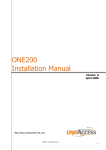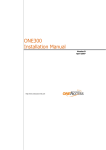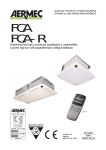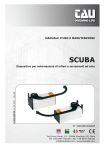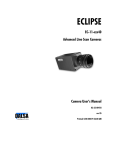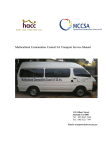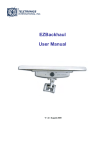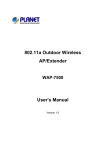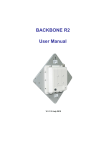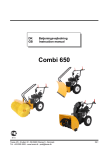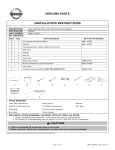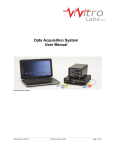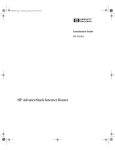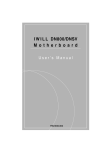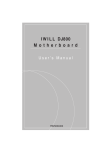Download ONE400 Installation Manual
Transcript
ONE400 Installation Manual Version A January 2006 1 OneAccess 28, rue de la Redoute 92260 Fontenay aux Roses France The law of 11 March 1957, paragraphs 2 and 3 of article 41, only authorizes, firstly, "copies and reproductions strictly reserved for use by copyists and not for general use and, secondly, analyses and short quotations for the purpose of example and illustration. Therefore, "any representation or reproduction, entire or partial, made without the consent of the author or his representatives is illegal" (paragraph 1 of article 40). Any such representation or reproduction, made in any manner whatsoever, would therefore constitute an infringement of the law as sanctioned by articles 425 and in accordance with the penal code. Information contained in this document is subject to change without prior notice and does not constitute any form of obligation on the part of ONEAccess. ONEAccess and the distributors can in no case be hold responsible for direct or indirect damage of any kind incurred as a result of any error in the software or guide. Every care has been taken to ensure the exactitude of information in this manual. If however you discover an error, please contact ONEAccess After Sales Service division. Edition January 2006 4030 00 T 4022 136 T 00 ind C 2 ABOUT THE INSTALLATION MANUAL This manual is divided into 6 chapters. Chapter 1 - Safety instructions This chapter gives the safety instructions. Chapter 2 - Directives and standards This chapter mentions standards to which the equipment comply with. Chapter 3 - Description of the equipment This chapter presents the equipment (front / rear panels) and gives the technical characteristics. Chapter 4 - Installation This chapter presents the equipment subsets, the hardware configuration to be made and the connections to be done. Chapter 5 - Power-up This chapter describes the equipment power on, the possible function changes and the progress of selftests. Appendix A - Connections This chapter describes the different necessary connection flexes for the equipment operation. 3 Table des Matières TABLE DES MATIERES .......................................................................................................................................4 1 1.1 1.2 1.3 1.4 SAFETY INSTRUCTION...........................................................................................................................5 Connections to the Main ............................................................................................................................5 Protection Against Overcurrent And Earth Faults.....................................................................................5 Safety Level of the Interface Circuits ........................................................................................................6 Lithium Battery ..........................................................................................................................................7 2.1 2.2 DIRECTIVES AND STANDARDS ...........................................................................................................8 Declaration of Conformity .........................................................................................................................8 Standards ....................................................................................................................................................9 3.1 3.2 3.3 3.4 DESCRIPTION OF THE EQUIPMENT................................................................................................10 Functional Presentation of the Equipment...............................................................................................10 Front Panel of the ONE400......................................................................................................................11 Rear Panel of the ONE400.......................................................................................................................12 Main Board...............................................................................................................................................13 4.1 4.2 4.3 4.4 4.5 4.6 4.7 4.8 4.9 4.10 4.11 4.12 INTERFACE DESCRIPTION .................................................................................................................14 LAN interface 10 BT (10BT) ..................................................................................................................14 LAN interface 10 BT (10BT) ..................................................................................................................15 Serial interface .........................................................................................................................................16 Console interface......................................................................................................................................17 Interface G.SHDSL, SDSL (M4).............................................................................................................18 IMA on E1 interface (M4) .......................................................................................................................19 STM1 interface (M4) ..............................................................................................................................20 Switch Ethernet interface (Switch) ..........................................................................................................21 FXS Analog Interface ..............................................................................................................................22 T0/S0 Interface (M5) ...............................................................................................................................24 T2 Interface (M5).....................................................................................................................................26 DSP 400 Module ......................................................................................................................................27 5.1 5.2 5.3 TECHNICAL CHARACTERISTICS .....................................................................................................28 Climatic Environment ..............................................................................................................................28 Power Supply Source ...............................................................................................................................28 Dimensions...............................................................................................................................................28 6.1 6.2 6.3 6.4 6.5 6.6 INSTALLATION .......................................................................................................................................29 Removal of the Protective Cover.............................................................................................................30 Voice Extension Module (M5) ................................................................................................................31 Installation of the DSP Module................................................................................................................33 Uplink Module (M4)................................................................................................................................34 Connections..............................................................................................................................................35 Installing into 19 inches Cabinet..............................................................................................................36 7.1 POWER UP ................................................................................................................................................37 Power-Up .................................................................................................................................................37 2 3 4 5 6 7 ANNEX A. SERIAL INTERFACE (VXX)..........................................................................................................38 ANNEX B. CONSOLE CORD .............................................................................................................................46 4 1 Safety Instruction This symbol instructs the user to consult the manual before any connection: 1.1 Connections to the Main The equipment may be connected to a TT or a TN type network, and only in Norway to an IT type with 240V between phases. : To connect the power supply, always follow these steps: • • Connect the power supply cable to the power input connector on the rear panel of the router, Connect the power supply to an AC electrical outlet (100-240 VAC). Plugging in the power supply turns on the router. Unplug the AC input before mounting/unmounting any part on the device. The AC input is the part you must disconnect first. For safety reasons, you shall be able to easily access this part. 1.2 Protection Against Overcurrent And Earth Faults The protection against earth faults is ensured by the building installation. The protection against overcurrent is implemented inside the power supply module and not serviceable. The earthing of the power supply box is made by the main plug cord. The output SELV part of the power supply are separated from the primary voltages by a reinforced insulation inside the power supply. The installation of the ONE400 must imperatively be carried out by a qualified maintenance personnel except in the case in which the interfaces may be considered to be SELV type (see above). In Norway and Sweden the equipment has to be permanently connected. A double pole disconnection device, easily accessible, and a 2A protection device against short circuit shall be incorporated to the building installation. 5 1.3 Safety Level of the Interface Circuits The add-on accessory modules and daughter boards must be installed only in the products authorized by OneAccess as recommended in the installation manual. 1.3.1 LAN Interface The Ethernet 10Base-T and 10/100Base-T auto-sense have "SELV" (Safety Extra Low Voltage) interface. They must be used only for indoor applications, connected to 10Base-T or 100Base-T interface which is also designed as "SELV". 1.3.2 Serial Interface (Vxx) The ONE400 has V.11, V.28, V.35 or V.36 line interfaces which are "SELV". They must be used only for indoor applications and connected to V.11, V.28, V.35 or V.36 interfaces which are also designed as "SELV" 1.3.3 SDSL/G.SHDSL Interface (M4) The ONE400 has SDSL/G.SHDSL interface (ITU-T G991.2) TRT1 type, destined to be connected directly to a standard telephone line (external). 1.3.4 T2/PRI interfaces (M5) The PRI401/404 module marked PBX/E1 DATA offers an ISDN primary interface (RJ45 connector). This interface is "SELV" and not destined to be connected to the public network. In case of indoor not exposed applications, this interface is intended to be connected to a S2/E1/T1 interface which is also designed as "SELV". In case of network E1/T1 applications, this interface is intended to be connected and protected from the network by a Network Termination which is also designed as "SELV". For Canada / USA applications the E1/T1 modes must be connected to a Certified / Listed Channel Service Unit (CSU). 1.3.5 FXS Interfaces (M5) The FXS module marked PBX/ access offers 4 to 8 FXS access (4 or 8 RJ45 connectors). These Interfaces are "TNV 2" (Telecommunications Network Voltage). The FXS module has a protective earth terminal symbolized by located on the back panel. This earth terminal must imperatively be permanently connected to a protective earth. 6 1.3.6 T0/S0 interfaces The BRI404-408 module marked PBX/T0 DATA offers up to 8 ISDN basic accesses, interface "Ia" (RJ45 connector). These interfaces are "SELV" and not destined to be connected to the public network, they must be connected only to an ISDN which is also designed as "SELV". 1.3.7 E1-IMA Interfaces The E1-IMA module offers up to 8 E1/T1 G703/704 interfaces (RJ45 connector). These interfaces are "SELV". 1.4 Lithium Battery The equipment has a calendar backed by lithium battery. This battery can be replaced only by maintenance personnel. Incorrect replacement of the battery may cause an explosion. Replace battery only using battery of the same type or an equivalent type recommended by the manufacturer. Discard used battery in accordance with the instructions of the manufacturer. Please, do not try to recharge, short-circuit, throw in water or fire as this may cause an explosion. 7 2 Directives and Standards 2.1 Declaration of Conformity 8 2.2 Standards The ONE400 is designed in conformity with the standards listed, provided that the basic housing, the modules, the interface boards and the kits are installed as recommended in the corresponding installation manuals. Sécurity EN60950 (2000) Safety of information technology equipment, including electrical business equipment. Environment : Climatic, physico chemical, mechanic, packing ETS 300 019-1 (95) Environmental conditions and telecommunication equipment environmental testing for In use : Temperature Controlled Test specification : Part 1, Classification of environmental conditions - class T3.1 (normal) - class T3.1 (exceptionnal) Storage: partly temperature controlled T1.1 Part 2, Specification of environmental test Transportation: careful Transportation T2.3 Electromagnetic Compatibility, immunity EN 55024 Information technology equipment immunity characteristics. Limits and methods of measurement. EN 55022 class B (98) Limits and methods of measurement of radio interference characteristics of information technology equipment . FCC part 15 class B Federal Communication Commission regulation (USA). EN 300386 V.1.3.1 (2001) EMC Requirements 9 3 Description of the Equipment 3.1 Functional Presentation of the Equipment The ONE400 is an equipment with box type which perform functions of concentrator, switch and multi-protocols router (WAN, LAN). In association with the transfer of data onto a WAN, LAN or Ethernet network, the ONE400 allows the connection from PABX or Telephonic Terminals with digital or analog interfaces for the voice transfer. The connection functions of PABX are obtained by adding modules inside the box of the ONE400.The ONE400 is equipped with three slots which can receive extension modules. The ONE400 in its basic configuration, is equipped with: • • • • 1 port for configuration and Debug (CONSOLE), 1 serial access V.28/V.11/V.35/V.36 type in DTE or DCE mode, with automatic selection according to the type of cable used (VXX), 1 LAN access 10Base-T (Ethernet) (10 BT), 1 LAN access 100Base-T (Ethernet) (100 BT). The different configurations which can be obtained in this way are delivered according to the order of the device. The hardware configuration is identified automatically and managed by the device during the initialization phase of the software. An extension module Fast Ethernet Switch 4 ports (10/100 BT) may be added into the slot (M1). The addition of an extension module into slot M4 allows the following optional services: • • • 1 access G.SHDSL (2 or 4 wires) or SDSL, 1 access IMA 4 or 8 E1 1 acess STM1 The addition of an extension module into slot M5 allows the following voice services: • • • 10 4 or 8 analog voice FXS 4 or 8 digital voice S0/T0 configurable mode TE or NT 1 or 4 digital voice S2/T2 3.2 Front Panel of the ONE400 The front panel of the ONE400 is provided with an indicator light which informs about the working status of the equipment. Figure 1. 3.2.1 Front Panel Meanings of the Indicator lights Indicator lights Off Green Red Green Flashing Status Switched Off Switched On operational Switched On not operational Reboot in progress xDSL Not used Synchronized Loss of synchronization Synchronization in progress on 1 interface IP Not used All the connections on IPoA or PPPoA are activated Connection failure on an IPoA or PPPoA - Aux Not used Data Service operational (FRF, CES) Failure on Data Service Voice Not used Service operational Service not operational Com No voice communication in progress Compression activated one or several channel 11 3.3 Rear Panel of the ONE400 The standard configuration of the rear panel is equipped with: • • • • • • • 1 serial port for configuration and debug (CONSOLE), 1 LAN access 10 Mbps (10BT), 1 LAN access 100 Mbps (100BT), 1 serial access port (MDR36 connectors), 1 slot for the extension module Uplink (M4), 1 slot for the extension module Ethernet switch (M1), 1 slot for the extension modules voice (M5), Figure 2. 12 Rear Panel 3.4 Main Board The basic version of the ONE400 is composed of a case including a motherboard associated to the power unit. The motherboard of the ONE400 brings: • The memory and CPU resources of the equipment: • 2 Mbytes of FLASH Boot, • 16 Mbytes of NANOFLASH, • 64 Mbytes of SDRAM, • The standard functionalities of the equipment: • 1 configuration/debug port, • 1 serial access V.28/V.11/V.35/V.36 type in DTE or DCE mode, with automatic selection of the type and the mode according to the cable used, • 1 LAN access 10Base-T (Ethernet), • 1 LAN access 100Base-T (Ethernet), • The connectors used to receive the modules and extension boards: • 1 connector for "voice" extension module (mark 1), • 1 connector for "uplink" extension board (mark 2), • 1 connector for Ethernet switch module (mark 3), • 2 connectors for the compression - decompression module(s) of the voice channels (DSP) (mark 5), Figure 3. MotherBoard 13 4 Interface Description 4.1 LAN interface 10 BT (10BT) 4.1.1 Characteristics • • 4.1.2 4.1.3 10Base-T Half or Full Duplex Meaning of LED Colors Lit green led Link active Blinking yellow led Traffic in progress Connector Pinout RJ45 Connector 4.1.4 Pin Signal Pion 1 TD (+) 5 Signal 2 TD (-) 6 RD (-) 3 RD (+) 7 NC 4 NC 8 NC NC Cables The cables are shielded, crossover/straight cables with 2 twisted pairs. The switch supports autodetection of crossover/straight cable (’auto-MDI/MDI-X detection’); 14 4.2 LAN interface 10 BT (10BT) 4.2.1 Characteristics • • 4.2.2 4.2.3 100Base-TX Half or Full Duplex Meaning of LED Colors Lit green led Link active Blinking yellow led Traffic in progress Connector Pinout Pin 4.2.4 Signal Pin Signal 1 TD (+) 5 NC 2 TD (-) 6 RD (-) 3 RD (+) 7 NC 4 NC 8 NC Cables The cables are shielded, crossover/straight cables with 2 twisted pairs. The switch supports autodetection of crossover/straight cable (’auto-MDI/MDI-X detection’); 15 4.3 Serial interface 4.3.1 Characteristics • • • • 4.3.2 RS 232, V.36, X.24, V.35, RS 449, EIA530, RIA530-A Interfaces DCE and DTE mode, Clock mode, contra directionnal and codirectionnal, Automatic detection of the interface characteristics thanks to pinout of the connected cable.. Cables The type of cable used on the serial link must be in conformity with the configuration. The installation of a cable on the serial link forces the mode of use (DTE or DCE) and the type (V.24 or V.28 or V.36) of the link. The automatic control of the type of cable used for the serial interface is carried out with the powering of the equipment. Imperatively to connect the cords at the two ends for the interface series before the powering of the equipment. All cables are defined in Appendix A 16 4.4 Console interface 4.4.1 Characteristics • • • 4.4.2 RS 232, 9600 bps 8 bits, 1 bit stop, no parity Connector Pinout Pin Signal Pin Signal TX 11 NC 2 RX 12 NC 3 GND 13 NC 4 NC 14 NC 5 NC 15 NC 6 NC 16 NC 7 NC 17 NC 8 NC 18 NC 9 NC 19 NC 10 NC 20 NC 1 • • • • 4.4.3 TX: Emission RX: Reception NC: Not Connected GND: Ground Cable The cable of connection to the interface Console is defined in Appendix A. 17 4.5 Interface G.SHDSL, SDSL (M4) The SDSL/G.SHDSL interface performed by the SDSL402 board allows to connect the ONE400 to a XDSL network. 4.5.1 Characteristics • • • • 2B1Q or PAM coding, ATM-based ETSI TS 101 135, ITU-T G.991.1, ANSI TR-28 for 2B1Q coding (single pair), ITU-T G.991.2 for G.SHDSL (Annex A and B), 2 or 4 wires. Capacity : • SDSL 2B1Q: 144 kbps up to 2,320 kbps • SHDSL 2 wires: 192 kbps up to 2,320 kbps • SHDSL 4 wires: 384 kbps up to 4,640 kbps The connection of the SDSL/G.SHDSL interface is made by means of a connector with RJ45 type. 4.5.2 Pin Signal Pin Signal 1 NC 5 RING 2 NC 6 NC 3 NC 7 NC 4 TIP 8 NC Cables The cable of connection to the G.SHDSL interface is made with a standard cable with the pinout above. 18 4.6 IMA on E1 interface (M4) The board realize an IMA (Inverse Multiplexer ATM) function on 4 or 8 E1 depending the board. The main characteristics are: • • • • • 4.6.1 ATM Forum IMA 1.0 and 1.1 compliant, IMA 4 voice and 8 voice component, Support 7 groups maximum (adresses limitation bus UTOPIA motherboard), Fractional E1, Support a delay of 110 ms (IMA 8 voice) without external memory. Connector Pinout 4 or 8 RJ45 conncetors Broche Signal 4.6.2 Broche Signal 1 RX (+) 5 TX (-) 2 RX (-) 6 NC 3 NC 7 NC 4 TX (+) 8 NC Cables The flex used for the E1 or T2 access is a shielded flex which contains 2 twisted pairs with pairing advised for the transmission pairs (4-5) and receive (1-2) with 2 RJ45 shielded connectors. 19 4.7 STM1 interface (M4) 4.7.1 Characteristics • • 20 Framer SONET/SDH (ATM), An optical module interface is available in many versions: Multimode (diode) 1300nm with interface type MT-RJ (distance <2Kms), Monomode (laser) 1300nm short haul with interface type LC (distance <15Kms), Monomode (laser) 1300nm long haul with interface type LC (distance <40Kms). 4.8 Switch Ethernet interface (Switch) 4.8.1 Characteristics The Switch Ethernet function offers 4 additional Ethernet ports. Each of them can be switched and/or routed. • • • • 4.8.2 10/100 Mbits/s, Half or full duplex, Auto-négociation, Auto MDI/MDIX. Meaning of LED Colors Lit green led Blinking yellow led 4.8.3 Link active Traffic in Progress Connector Pinout RJ45 Connector 4.8.4 Pin Signal Pin 1 TD (+) 5 Signal 2 TD (-) 6 RD (-) 3 RD (+) 7 NC 4 NC 8 NC NC Cables The cables are shielded with 2 twisted pairs and 2 shielded connectors RJ45. The switch supports auto-detection of crossover/straight cable (’auto-MDI/MDI-X detection’); 21 4.9 FXS Analog Interface The ONE400 equipped with FXS interfaces allows to connect the PABX which have network junctor access, but allow also to connect directly some analog telephones or fax. Configuration of the FXS interfaces The configuration of the access impedance is made by means of jumpers to set manually on the FXS interface board as indicated in the following table: 4.9.1 Characteristics of the FXS accesses: • • • • • • • • • • 4.9.2 Access impedance : 600 Ω or complex, selection by jumpers, THL> 20 dB in the frequency range from 300Hz to 3400Hz, Frequency range of the ringing signal: 16Hz to 70 Hz, Voltage of the ringing signal: > 35VRMS for a load of 1 REN (6,93K + 8µF @ 20Hz) in the frequency range, Line current : 22mA <I line> 26mA, for a line resistance <1000 Ω, Polarity inversion of the TIP and RING pins, Line current <2mA in the power down mode, Detection threshold of the picked up : 5mA <I line> 12mA, Q23 numbering, Connector Pinout The connection to the analog voice accesses is made on the rear panel by RJ45 connectors in accordance with the following pinouts: Pin 22 Signal Pin Signal 1 NC 5 RING 2 NC 6 NC 3 NC 7 NC 4 TIP 8 NC 4.9.3 Cables The cable used for a connection toward a PABX toward a standard analog set in FXS is constituted with a RJ45 plug on one hand and with 8 wires on the other hand, two of which are to be connected to the distributor of the PABX or to a telephonic plug. The FXS modules have a terminal marked located on the rear panel. This terminal must be imperatively connected to the main protective earth in a permanent way (refer to Chapter 1, Safety instructions). 23 4.10 T0/S0 Interface (M5) The BRI404/408 module allows to equip the ONE400 with 4 or 8 interfaces "digital voices" T0/S0 configurable as TE or NT. The use of this module requires the installation of one DSP module for VoIP or VoDSL applications. The ONE400 can receive one module BRI404/BRi408 which have 4 or 8 digital interfaces. The connection of the digital voice interfaces is made on the rear panel by RJ45 connectors (1 connector per interface). The modules BRI404/BRI408 in factory configuration, are configured in T0 mode. Do not connect the interfaces to a public ISDN access, which can damage the product immediately. 4.10.1 Configuration of the motherboard (BRI404 – BRI408) Un emplacement spécifique a été implanté pour ranger les cavaliers non utilisés. Jumpers X5 (factory option of the BRI404 and BRI 408) Function Configuration Factory Config. Activates the Life Line function Set : Life Line function inactive Removed : Life Line function active Set Jumpers X6 (factory option of the BRI404 and BRI 408) Function Configuration Factory Config. Activates the watchdog of the Life Line function (activated in normal running) Set : watchdog active Removed : watchdog inactive Set Jumpers [X1;X2] [X7;X8] [X11;X12] [X15;X16] Function Configuration Factory Config. 24 Operating in pairs, activate power feeding for ISDN terminals from line #0 up to #3 (30 volts) Set : Power supply connected (both jumpers set) Removed : Power supply disconnected (both jumpers removed) Set Cavaliers [X3;X4] [X9;X10] [X13;X14] [X17;X18] Operating in pairs, connect a 100Ω impedance adaptation for line #0 up to #3, the first jumper of the pair is associated with the reception, the second one with the transmission Set : Adaptation connected Removed : Adaptation disconnected Set Function Configuration Factory Config. 4.10.2 Configuration of the board (BRI408) A specific location is available to leave the unused jumpers. Cavaliers [X1;X2] [X5;X6] [X9;X10] [X13;X14] Operating in pairs, activate power feeding for ISDN terminals from line #0 up to #3 (30 volts). Set: Power supply connected (both jumpers set Removed: Power supply disconnected (both jumpers removed) Set Function Configuration Factory Config. Cavaliers [X3;X4] [X7;X8] [X11;X12] [X15;X16] Operating in pairs, connect a 100Ω impedance adaptation for line #0 up to #3, the first jumper of the pair is associated with the reception, the second one with the transmission. Set Adaptation connected Removed Adaptation disconnected Set Function Configuration Factory Config. 4.10.3 Connector Pinout The connection to the BRI accesses is made on the rear panel via RJ-45 connectors. The RJ45 connector pinout is: Pin Signal Pin Signal 1 NC 5 TX (-) 2 NC 6 RX (-) 3 RX (+) 7 NC 4 TX (+) 8 NC 25 4.11 T2 Interface (M5) The PRI431 module allows to equip the ONE400 with a E1/T2 G703/G704 "digital voice" access. Associated to DSP compression - decompression modules, this interface allows to process until 30 voices channels (2 DSP modules). The external connection of the E1/T2 interface is made on the rear panel by RJ45 connector. 4.11.1 Connector Pinout RJ45 connectors 4.11.2 Pin Signal Pin Signal 1 RX (+) 5 TX (-) 2 RX (-) 6 NC 3 NC 7 NC 4 TX (+) 8 NC Cables The flex used for the E1 or T2 access is a shielded flex which contains 2 twisted pairs with pairing advised for the transmission pairs (4-5) and receive (1-2). 26 4.12 DSP 400 Module The DSP400 module(s) are used in association with the BRI434, PRI431 and AVB434 modules. These modules achieve the processing functions of compression - decompression for the voices channels. Two types of module are available: • • the DSP401 module, equipped with 1 DSP processor, the DSP402 module, equipped with 2 DSP processors. The NT mode configuration of the BRI434 module allows to provide a power supply Source 1 sufficient for detecting but self-supplied terminals. The ONE400 supports 1 to 2 DSP module and can process until 30 voices channels. The DSP modules are secured and connected to the motherboard by a 80 pins SIMM connector. The below table recalls the number of DSP modules required for the operation of the different modules : Type of “voice” module Number of DSP modules required FXS404 DSP401 FXS408 DSP401 BRI404 DSP401 BRI408 DSP402 PRI401 (8 chanel) DSP401 PRI401 (16 chanel) DSP402 PRI401 (24 chanel) DSP402 + DSP 401 PRI401 (32 chanel) DSP402 + DSP402 27 5 Technical Characteristics 5.1 Climatic Environment Operating conditions: • • • • • Temperature: 0°C ≤ T ≤ 45°C Relative humidity (HR): 5% ≤ HR ≤ 80% Absolute humidity: ≤ 24g / m3 Altitude: ≤ 2500 m Air pressure: 70 à 80kPa Storage conditions: • • • • • Temperature: -25°C ≤ T ≤ 55°C Relative humidity (HR): 5% ≤ HR ≤ 95% Absolute humidity: ≤ 29g / m Altitude: ≤ 2500 m Air pressure: 70 à 80kPa 5.2 Power Supply Source • 90-250 VAC / 0.7-0.3 A inserted power supply 5.3 Dimensions The dimensions of the ONE400 are: • • • 28 Width: 440 mm Height: 48 mm) Depth: 278 mm 6 Installation This chapter describes installation and removal operations of necessary subsets at the time of retrofitting, modification of configuration or maintenance of the equipment Interventions on the ONE400 equipment are made in power off mode and require the removal of the upper protective cover. Remove the power cable before any intervention on the device. The ONE400 equipment is equipped with an automatic detection and identification system of each of its subsets and its configuration reducing to the minimum the configuration operations of the equipment. ll vacant slots of the rear panel must be obstructed with suitable face-plates in order to guarantee the respect of the CEM standards as defined in Chapter 2, Directives and standards. 29 6.1 Removal of the Protective Cover 1 By means of a Posidriv N°1 screwdriver, unscrew and remove the 2 fixing screws of the protective cover. 2 slide the cover in order to free the inserts. 3 remove the protective cover from the top of the equipment. Figure 4. 30 Removal of the protectivecover 6.2 Voice Extension Module (M5) The exchange or the installation of extension module requires the removal of the up per protective cover of the equipment. The extension modules can be installed into the slots marked "M5".The configuration is detected automatically, controlled and taken into account when powering up the equipment. Figure 5. Installation and Removal of voice extension module 31 6.2.1 Removal of a Voice Extension Module • • • 1 Unlock and remove the fixing screws of the module on the rear panel. 2 Unlock the fixing brace of the module on the motherboard. 3 Loosen the module from the motherboard connection connector. 6.2.2 Rise up the board as indicated. See Figure 5. 6.2.3 Installation of a Voice Extension Module • • • • • • 1 Remove the protective faceplate of the frame, in order to free the slot of the interfaces connection connector(s). 2 Present the module while positioning the metallic face in the place liberated by the removal of the faceplate. 3 Turn the module round while aligning the connection connector of the SDSL402 board with the motherboard connector. 4 Slot the module connector into the motherboard connector. 5 Fix the module on the motherboard while using the brace of the module. 6 Fix the module on the rear panel of the ONE400 while using the fixing screws of the faceplate. The FXS modules have a terminal marked located on the rear panel. This terminal must imperatively be connected to the main protective earth in a permanent way. 32 6.3 Installation of the DSP Module Interventions on DSP modules require the removal of the protective cover of the equipment. The DSP modules can be installed indifferently in the 2 reserved locations (reference marks 7 Figure 3 page 3-5). The configuration is automatically detected, controlled and taken into account during the powering up of the equipment. Make sure not to place by mistake a DSP module in the connector destined to the IPSEC module (reference mark 4. Connectors provided for receiving the DSP modules are equipped with two clips in their extremity. Figure 6. Installation of the DSP module To withdraw the headers: 1 Separate slightly and simultaneously the two clips toward the outside. The header must tilt of its own. 2 Loosen the header upwards. The memory headers have a lateral punching which serves as fool proofing device. To install the headers: 1 Put, face-to-face, this header punching with the "boss" of the connector located on the motherboard. 2 Slot the memory header, in tilted position, and straighten this one firmly (the lateral clips lock the header in vertical position). 33 6.4 Uplink Module (M4) The exchange or the installation of an Uplink module requires the removal of the upper protective cover of the equipment. The Uplink module is installed in the slot "M4". The available Uplink modules are:• • • 6.4.1 SDSL402 board,-E1 IMA404/408 board, SDH400MM board. Removal of an Uplink Module 1 Unlock the 2 fixing braces of the Uplink module on the rear panel of the ONE400. 2 Loosen the Uplink module from the connection connector to the motherboard. 3 Rise up and loosen the board from its emplacement. 6.4.2 Installation of an Uplink Module 1 2 3 4 5 . 34 Remove the protective faceplate of the frame, in order to free the slot of the interface connection connector. Present the Uplink module while positioning the metallic face in the place liberated by the removal of the faceplate. Turn the Uplink module round while aligning the connection connector of the Uplink module with the motherboard connector. Slot the connector of the Uplink module into the motherboard connector. Fix the Uplink module on the rear panel of the ONE400 while using the fixing screws of the faceplate 6.5 Connections 6.5.1 Protective Earth An earthing device is available on the FXS modules and must imperatively be connected to the main protective earth. Figure 7. 6.5.2 Main protective earth Mains Power Supply The main is connected directly on the rear panel of the ONE400 equipment. The mains flexes are delivered with the ONE400, in accordance with the mains connection standard of the region of use, specified at the time of the equipment order. Figure 8. Main power Supply 35 6.6 Installing into 19 inches Cabinet The ONE400 may be installed in a 19 inches cabinet by using a kit with corners. Figure 9. 19 Inches Cabinet Installation Kit 1 Install the 4 captive nuts on the uprights of the cabinet. 2 Screw the corners on the uprights of the cabinet. 3 Install the ONE400 on the corners, the ONE400 supports must be inserted in the corners holes. Figure 10. 36 ONE400 Installed in 19 Inches Cabinet 7 Power Up 7.1 Power-Up The equipment is powered up by connecting the main cord of the ONE400 to the power supply. After a delay of a few seconds, the equipment performs a series of self-tests and loads the software into memory (RAM), during which the "STATUS" indicator light flashed. At the end of the software loading sequence (about 20 seconds): • the "STATUS" indicator light remains steady green if the initialization took place correctly, • the "STATUS" indicator light remains flashing in case of software absence or error during the software loading. Refer to the ONEOS User Guide for more information. 37 Annex A. Serial Interface (VXX) A-1. V.24 / V.28 DTE Cord Catalog: reference 4 021 863 00 Ed A P1 P2 - P1 MDR 36 Pts Ecran 1 2 3 4 5 6 7 8 9 10 11 12 13 14 15 16 17 18 19 20 21 22 23 24 25 26 Blindage 103 (SD) 113 (TXCE) 114 (TXC) 115 (RXC) 104 (RD) - P2SUB-D 25 Pts mâle 1 + Capot 2 24 15 17 3 105 (RTS) 108 (DTR) 4 20 109 (CD) 107 (DSR) 106 (CTS) 141 (LL) 142 (TM) 8 6 5 18 25 102 Ident0 Ident2* 7 125 (IA) 140 (RL) 22 21 SIGNAL 27 28 29 30 31 32 33 34 35 36 102 Ident1* Ident3 * Signal connected to pin 34 at the end of the cable 38 A-2. V.24 / V.28 DCE Cord Catalog: reference : 4 021 864 00 Ed A P1 P2 - P1 MDR 36 Pts Ecran 1 2 3 4 5 6 7 8 9 10 11 12 13 14 15 16 17 18 19 20 21 22 23 24 25 26 27 28 29 30 31 32 33 34 35 36 Blindage 104 (RD) 115 (RXC) 114 (TXC) 113 (RXCE) 103 (SD) - P2SUB-D 25 Pts femelle 1 + Capot 3 17 15 24 2 106 (CTS) 107 (DSR) 5 6 109 (CD) 108 (DTR) 105 (RTS) 125 (IA) 140 (RL) 8 20 4 22 21 102 Ident0* Ident2* 7 141 (LL) 142 (TM) 18 25 SIGNAL 102 Ident1 Ident3 * Signal connected to pin 34 at the end of the cable 39 A-3. V.36 DTE Cord Catalog: reference: 4 021 865 00 Ed A P1 P2 - P1 MDR 36 Pts Ecran 1 2 3 4 5 6 7 8 9 10 11 12 13 14 15 16 17 18 19 20 21 22 23 24 25 26 27 28 29 30 31 32 33 34 35 36 Blindage 103A (SD) 113A (TXCE) 114A (TXC) 115A (RXC) 104A (RD) - P2SUB-D 37 Pts mâle 1 + Capot 4 17 5 8 6 105A (RTS) 108A (DTR) 7 12 109A (CD) 107A (DSR) 106A (CTS) 141 (LL) 142 (TM) 102a 102 Ident0 Ident2* 103B (SD) 113B (TXCE) 114B (TXC) 115B (RXC) 104B (RD) 13 11 9 10 18 37 19 105B (RTS) 108B (DTR) 25 30 109B (CD) 107B (DSR) 106B (CTS) 125 (IA) 140 (RL) 102b 102 Ident1 Ident3 31 29 27 15 14 20 SIGNAL * Signal connected to pin 34 at the end of the cable 40 22 35 23 26 24 A-4. V.36 DCE Cord Catalog: reference : 4 021 866 00 Ed A P1 - P1 MDR 36 Pts Ecran 1 2 3 4 5 6 7 8 9 10 11 12 13 14 15 16 17 18 19 20 21 22 23 24 25 26 27 28 29 30 31 32 33 34 35 36 P2 Blindage 104A (RD) 115A (RXC) 114A (TXC) 113A (TXCE) 103A (SD) - P2SUB-D 37 Pts femelle 1 + Capot 6 8 5 17 4 106A (CTS) 107A (DSR) 9 11 109A (CD) 108A (DTR) 105A (RTS) 125 (IA) 140 (RL) 102b 102 Ident0* Ident2 104B (RD) 115B (RXC) 114B (TXC) 113B (TXCE) 103B (SD) 13 12 7 15 14 20 19 106B (CTS) 107B (DSR) 27 29 109B (CD) 108B (DTR) 105B (RTS) 141 (LL) 142 (TM) 102a 102 Ident1* Ident3 31 30 25 10 18 37 SIGNAL 24 26 23 35 22 * Signal connected to pin 34 at the end of the cable 41 A-5. X.21/V.11 DTE Cord Catalog: reference : 4 021 867 00 Ed A P1 P2 - P1 MDR 36 Pts Ecran 1 2 3 4 5 6 7 8 9 10 11 12 13 14 15 16 17 18 19 20 21 22 23 24 25 26 27 28 29 30 31 32 33 34 35 36 Blindage 103 (TA) 113 (XA) - P2SUB-D 15 Pts mâle 1 + Capot 2 7 115 (SA) 104 (RA) 6 4 105 (CA) 3 109 (IA) 5 102 Ident0 Ident2 103 (TB) 113 (XB) 8 9 14 115 (SB) 104 (RB) 13 11 105 (CB) 10 109 (IB) 12 SIGNAL 102 Ident1* Ident3 * Signal connected to pin 34 at the end of the cable 42 A-6. X.21/V.11 DCE Cord Catalog: reference : 4 021 868 00 Ed A P1 P2 - P1 MDR 36 Pts Ecran 1 2 3 4 5 6 7 8 9 10 11 12 13 14 15 16 17 18 19 20 21 22 23 24 25 26 27 28 29 30 31 32 33 34 35 36 Blindage 104 (RA) 115 (SA) - P2SUB-D 15 Pts femelle Capot 4 6 113 (XA) 103 (TA) 7 2 109 (IA) 5 105 (CA) 3 102 Ident0* Ident2 104 (RB) 115 (SB) 8 11 13 113 (XB) 103 (TB) 14 9 109 (IB) 12 105 (CB) 10 SIGNAL 102 Ident1 Ident3 * Signal connected to pin 34 at the end of the cable 43 A-7. V.35 DTE 1 mm Cord Catalog: reference : 4 022 170 00 Ed A P1 P2 - P1 MDR 36 Pts Ecran 1 2 3 4 5 6 7 8 9 10 11 12 13 14 15 16 17 18 19 20 21 22 23 24 25 26 27 28 29 30 31 32 33 34 35 36 Blindage 103A (SD) 113A (TXCE) 114A (TXC) 115A (RXC) 104A (RD) - P2connecteur mâle A + Capot P U Y V R 105A (RTS) 108A (DTR) C H 109A (CD) 107A (DSR) 106A (CTS) 141 (LL) 142 (TM) F E D L NN 102 Ident0 Ident2* 103B (SD) 113B (TXCE) 114B (TXC) 115B (RXC) 104B (RD) B S W AA X T 125 (IA) 140 (RL) J N SIGNAL 102 Ident1 Ident3* * Signal connected to pin 34 at the end of the cable 44 A-8. V.35 DCE 1 mm Cord Catalog: reference : 4 022 171 00 Ed A P1 P2 - P1 MDR 36 Pts Ecran 1 2 3 4 5 6 7 8 9 10 11 12 13 14 15 16 17 18 19 20 21 22 23 24 25 26 27 28 29 30 31 32 33 34 35 36 Blindage 104A (RD) 115A (RXC) 114A (TXC) 113A (TXCE) 103A (SD) - P2connecteur femelle A + Capot R V Y U P 106A (CTS) 107A (DSR) D E 109A (CD) 108A (DTR) 105A (RTS) 125 (IA) 140 (RL) F H C J N 102 Ident0* Ident2 104A (RD) 115B (RXC) 114B (TXC) 113B (TXCE) 103B (SD) B T X AA W S 141 (LL) 142 (TM) L NN SIGNAL 102 Ident1* Ident3* * Signal connected to pin 34 at the end of the cable 45 Annex B. Console Cord Catalog: reference : 4 021 856 00 Ed A 46 MDR 20 Pts - P1 SIGNAL SUB-D 9 Pts Femelle - P2 1 2 3 TX RX GND 2 3 5 7 8















































